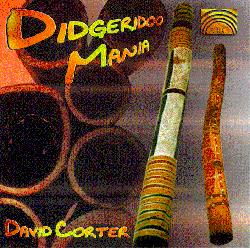
![]() Sorry, no audio yet.
Sorry, no audio yet.
![]()
![]() Artist:
Artist:
Corter, David
![]() Title:
Title:
Didgeridoo Mania
![]() Genre:
Genre:
World
![]() Musicians:
Musicians:
| Musician | Instruments |
|---|---|
| David Corter | didjeridu, clay whistle, bullroarer, Jew's harp, bamboo flutes, gong, guitar, bowed cymbals, tambura, boomerangs |
| Brian Estep | acoustic and electric guitar, national steel guitar |
| David Shuman | double bass |
| Michael Szekely | percussion |
| David Cossin | tube, berimbau, hadgini drum, djembe, Tibetan singing bowls |
| Bradfort Reed | electronic chirps and tweets |
| Nina Nastasia | vocals |
| John McDonough | trumpet |
| Chris Bowen | thumb piano, talking drum |
| Craig Rodriguez | percussion, electronic treatments |
![]() Format:
Format:
CD, Playing time 65:16 minutes
![]() Track List:
Track List:
![]() Publisher No.:
Publisher No.:
(1997) Arc Music - EUCD 1432
, Arc Music America, PO Box 2453, Clearwater FL, 34617, email: info@arcmusic.co.uk
![]() Comments:
Comments:
Didgeridoo Mania, Arc Music's latest didjeridu-oriented release is a collaborative album by David Corter, a musician based in New York City. David Corter has been playing for seven years, and has studied with Bill Harney of the Wardaman Tribe, a didjeridu creator and player. David describes his recording in the liner notes saying "My approach to the CD was more conceptual (in the vein of Webern or Ornette Coleman) than compositional. My main objective was to create color and mood using the digeridioo as the primary color and then blending it with other idigenous instruments. I aslo wanted to show that all indigenous instruments have a common denominator, a certain tone or feeling (which we associate with trance music). As for the western instrumentation, it was used in an unconventional or abstract manner to simulate that common denominator. The listener should also know that the musicians on the the recording were never told to play a specific line or note; I conveyed only general thoughts and concepts, which they interpreted. The result is a music which has the ability to take you any place you wish to go."
David's description of the music is accurate; his abstraction of the western instrumentation has the flavor of modern jazz improvisations. The second piece in particular, Gizra, has this property. The opening song, Sun-go-down, is a short and beautiful integration of didjeridu, clay whistle and bull-roarer that quickly got my attention. The third piece, The King Brown, is solo didjeridu that honors the snake that gave the didjeridu to the people. It is a traditional piece.
Butcher Bird and the Dingo is a piece melding together electronically processed hand-drumming in a style similar to the Indian tabla, with controlled feedback and finally, after the rhythm and feedback counterpoint is established, the didj joins in. This piece has a very trance feel due to the relentless drumming and the repetitive nature of the the feedback. I'm actually sorry that this song isn't longer.
Outside the Haus Tambaran has a slower, slightly melancholy, somewhat mysterious feel with slow, deep drum beats intertwined with sinuous didjeridu, and Nina Nastasia's breathy vocals. The berimbau is used to good effect, creating dissension against the other instruments.
Within the Current highlights the squawky, awkward honking of John McDonoough on trumpet. Corter plays a constant background drone while the clay pot drums sound almost like a plucked string bass.
The Shadow of Whom begins like a thousand other didj solos - "BEEyeeeooorrrr", then continues with a good traditional playing that features vocalizations in tune with the didjeridu.
The Ballad of the Domdens should have interpretive dancers on stage with it. The bowed cymbals open the movement very slowly, with didjeridu and trumpet joining in to change the sound to something like a darker piece of Miles Davis on Sketches of Spain. Perhaps this is appropriate since the domdens are Tibet's versions of undertakers.
Frontier Intruders has the didj, djembe, tambura and trumpet creating a slow dance that is intruded upon by the guitar, in disonent tones and rhythms. The guitar perseveres, the trumpet counters with true notes, and the slow dance of the indigenous peoples continues.
Prelude is a meditative solo on Tibetan singing bowls, very nice.
Nina's despairing and almost desparate vocals on Final Call and the urgency of the didjeridu playing come together to form a powerful final call, with the double bass joining in the end with a rasping, crying tonality. The traditional bounce breath rhythm is used to great effect on this piece.
How Loud the Silence Is is an extended (twelve minute) guitar feedback piece, so be ready! The liner notes explain that this is about living in New York City, so I guess it is apt. It is not easy to listen to, since it takes more than 12 minutes to de-sensitize yourself to NYC.
All in all, I was very nicely surprised by the depth and quality of this recording. Corter has something good to say in the space between traditional playing and modern culture. Good for Arc for recognizing it!
Reviewer: John Morfit